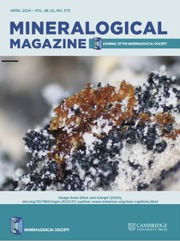Article contents
Chromian-manganoan augite in the interchondrule matrix of the Tieschitz (H3) chondritic meteorite
Published online by Cambridge University Press: 05 July 2018
Abstract
The Tieschitz chondrite is a disequilibrium assemblage of silicate, metal and sulphide occurring together or separately as chondrules and clasts that generally have opaque rims (matrix) of fine-grained material. Translucent, silicate-rich matrix fills channels that occur sporadically between chondrules and clasts. An angular fragment of twinned ‘clinoenstatite’ was found to be rimmed with chromium- and manganese-rich augite and surrounded by opaque matrix. The whole is set within the largest area of translucent (white) interchondrule matrix encountered. It is suggested that reaction between crystallizing undersaturated translucent matrix, opaque matrix, and clinoenstatite probably led to the partial replacement of clinoenstatite by chromian-manganoan augite at high temperature.
Keywords
Information
- Type
- Meteorite Studies
- Information
- Copyright
- Copyright © The Mineralogical Society of Great Britain and Ireland 1987
References
- 8
- Cited by

